Emilie St-Hilaire is a multidisciplinary artist and doctoral candidate in Concordia’s Humanities PhD program. She is studying the idiosyncratic and widely misunderstood practice of reborn doll collecting from a feminist perspective. She has published in the journal RACAR on the topic of research-creation and has exhibited her artwork at galleries and festivals nationally and internationally. Her doctoral research has been supported by scholarships from the FRQSC, Concordia University, Hexagram Network and Francofonds.
Blog post
Beyond scaring crows
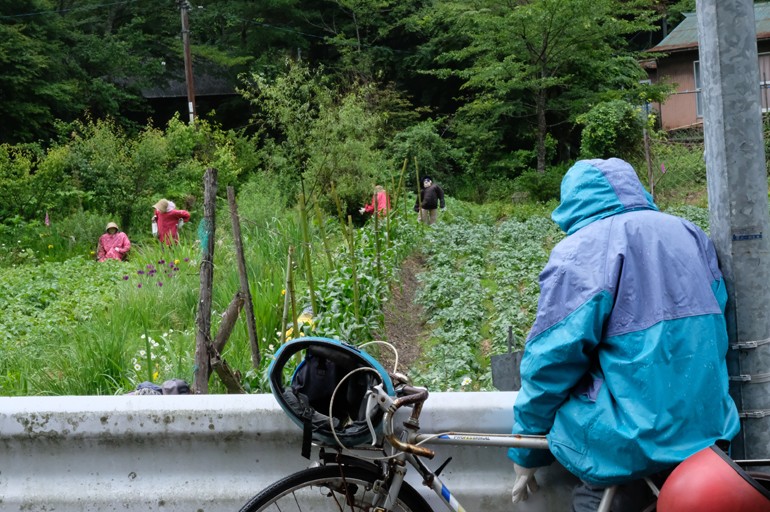 Scarecrows are posed throughout the village of Nagoro. | All images by Emilie St-Hilaire unless otherwise indicated.
Scarecrows are posed throughout the village of Nagoro. | All images by Emilie St-Hilaire unless otherwise indicated.
Tucked in Japan's Iya Valley region, there is a Scarecrow Village where life-sized dolls outnumber the residents. I was packing for a trip to Japan when a friend sent me an article about this village called Nagoro. I immediately researched how to get there and found that renting a car would be the most reliable route to the Iya Valley. I picked up an international driver’s license the day before leaving Montreal for Tokyo.
Three years ago, in 2016, I began to learn about the thousands of adults around the world who enjoy collecting hyper-realistic baby dolls called reborn babies. Since then, I’ve been researching these and other kinds of dolls. Dolls have been around for thousands of years. We make dolls from almost any material and children often create crude dolls that function just as well — or better — than the fanciest bébés found in stores.
It’s become clear to me, though, that dolls are not just for kids. I’ve recently begun examining the relationship between dolls and robots, so I hope to see some robotic humanoids in Japan in addition to the scarecrows of Nagoro.
June 19, 8:52 p.m.
Takamatsu, Kagawa Prefecture, Shikoku Island
I’ve checked into a quiet and dated hotel near the airport chosen due to its proximity to a rental car dealership. A five-hour journey on a high-speed train brought me the 600 kilometres from Tokyo to Takamatsu. In the morning, I will pick up a car and set off towards Nagoro and the mountains in the south. Before falling asleep I mentally prepare myself for driving on the left side of the road.
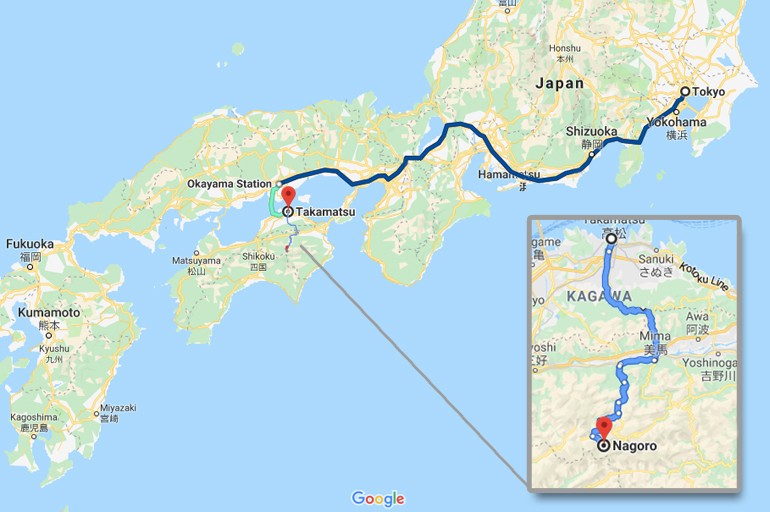
June 20, 10:08 a.m.
Tokushima Prefecture, Shikoku Island
I’ve only been driving toward the Iya Valley for 30 minutes and the scenery is incredible. Almost immediately I start pulling over to stare down toward the Anabuki River and get a few pictures. The road hugs the mountainside and there’s always water flowing down below. I can’t wait to get deeper into these lush mountains. So far, I’ve completely underestimated the amount of time it will take to drive the 98 kilometres to Nagoro.
Although smooth, the road is narrow and I rarely go over 40 kilometres per hour due to the sharp turns and switchbacks that greet me in succession. The cliffs, panoramic views and occasional deer must be ignored if I’m going to make it to Nagoro before nightfall. I actually need to have this little silver Nissan back in Takamatsu before 7 p.m.
My altitude climbs to more than 1,000 metres and I often have to shift over to the left to make way for oncoming vehicles. Soon though, I get accustomed to scanning the round mirrors perched at sharp turns and the drive becomes overwhelmingly enjoyable.

It’s 1:30 p.m. and I still haven’t reached Nagoro
I know I should resist pulling over yet again, but I stop at one more lookout point. This one is positioned with a sublime view of a mountainside farming village. I follow a short trail downhill for a better vantage point and, suddenly, I’m facing a group of scarecrow dolls beneath a shelter. We stare at each other.
Arranged in a tight cluster, they look as though they are patiently awaiting their bus. Their fabric faces are surprisingly expressive. Is it possible that they are just as happy to see me as I am to see them?
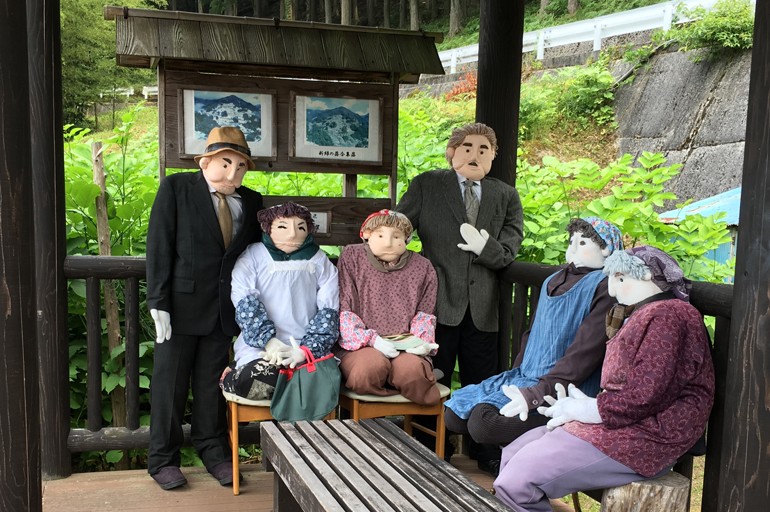
One figure is holding a stack of colourful pamphlets. Inside there is a map of the Scarecrow Village and information about the creator of the dolls, Tsukimi Ayano.
Ayano made her first scarecrow in 2002 upon returning to Nagoro after living in Osaka for many years. She made him in the likeness of her late father, as she suspected this would help her crops. Soon, Ayano noticed her neighbours would stop and wave to the scarecrow. She decided to make more and she has now made hundreds of them.
The craft took off in the village, with many people joining in to create these characters. There is even an annual Scarecrow Festival. Ayano recalls Nagoro being a vibrant place when she was young but the automation of a local dam caused rapid depopulation. As of March 2018, there are 29 residents left, down from 300, decades ago.
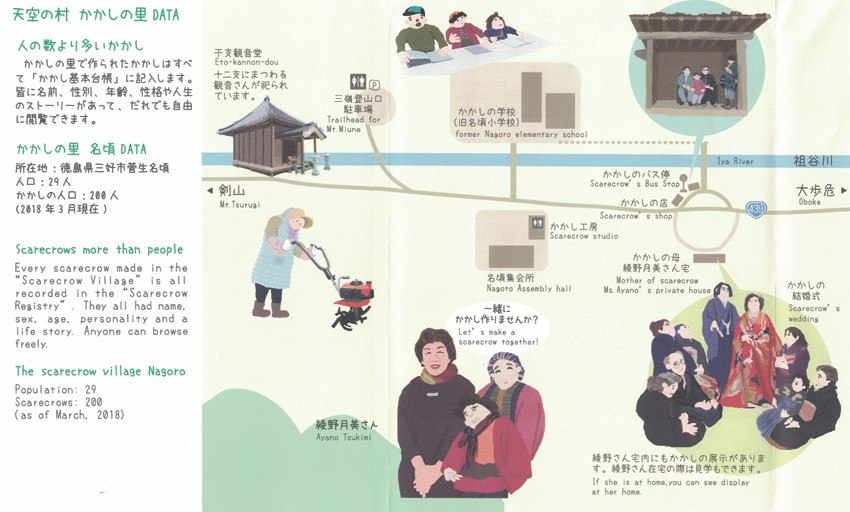 Centre page from the Nagoro Village of Scarecrow brochure.
Centre page from the Nagoro Village of Scarecrow brochure.
2:28 p.m.
Nagoro, Tokushima Prefecture, Shikoku Island
The afternoon becomes overcast as I get back on the road toward Nagoro. Just when I start to worry I may have missed the village completely, I see an elderly couple slumped together on log stools. They are very still. Looking up ahead, I see a few more figures alongside the road. Here they are! I’ve arrived in Nagoro. The village is a collection of buildings on either side of the highway.
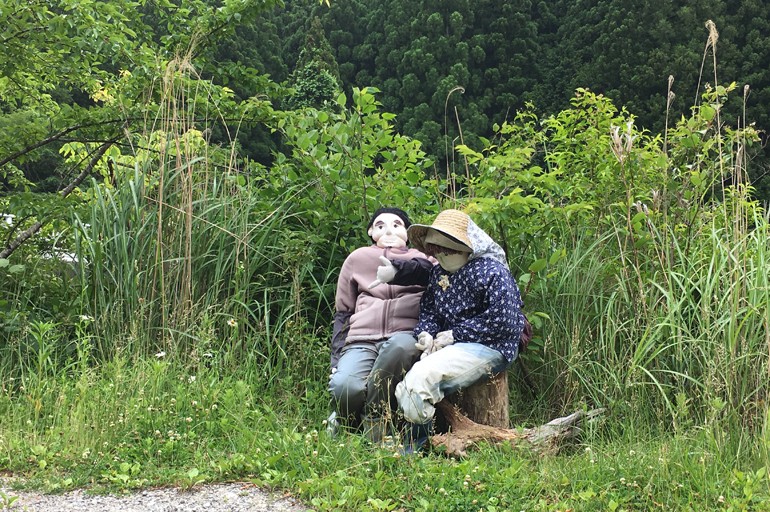
I pull over to walk along the road with my camera. Through a fence I can see several figures in a large vegetable garden, and one figure is moving. That one is a real person. This gardener blends right into the scarecrows around her. Do they keep her company?
Next door there’s a wide driveway that leads me to two figures sitting in an open garage. They sit quietly staring at a few pieces of pottery on a table. An old green chalkboard sags on the wall behind them. Messages from tourists cover the chalkboard:
"Hello from Tampa!"
"Halifax, NS"
"ESPAÑA"
This apparent abundance of visitors clashes with the silence that surrounds me here.
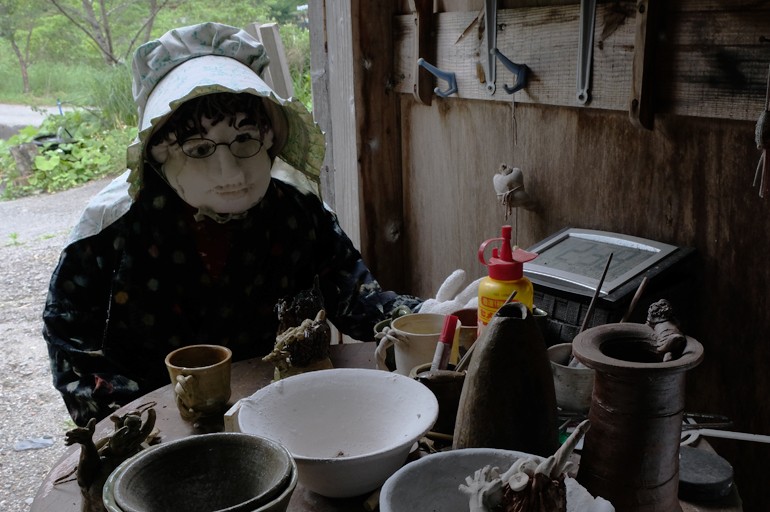
What is striking about these adult-sized figures is that unlike a storefront mannequin, which is confined to a commercial space, the placement of these dolls within the landscape enhances the uncanniness of their organic form. They simultaneously belong and don’t belong as they occupy the spaces of people.
Wearing retired clothing, including hats and shoes, they’re often posed mid-action. A scarecrow leans in a casual contrapposto against a rake. A bored-looking family seems to be waiting for a local shop to open. It never does. Even though I know these are not real people, it is the habit of my mind to read them as human.
This discord between knowing and seeing gets to the core of uncanniness. Sigmund Freud described the uncanny as the feeling of something that is at once familiar — home-like — and unfamiliar. Having doubt about the realness of a human, or the human-ness of a doll, triggers a sense of creepiness. If this is a person why don’t they move? If this is not a person, why are they here?
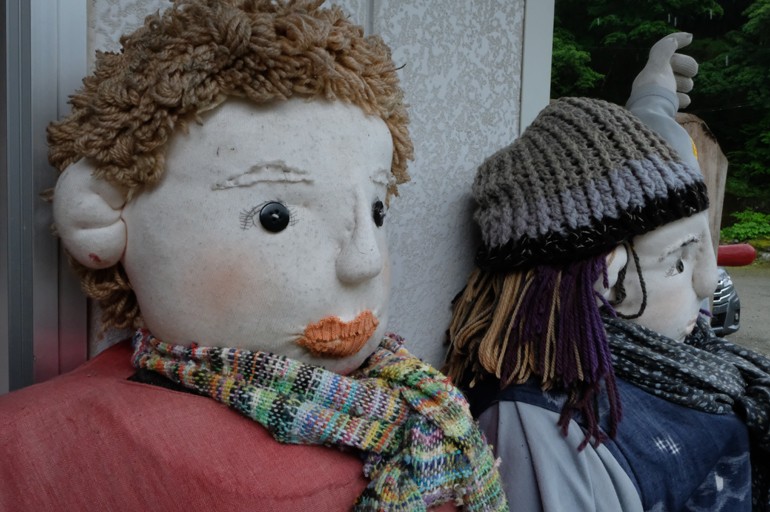
A drop of rain hits me. A grey cloud has been encroaching and is now overhead. I should have arrived earlier! I hop back in the car and drive slowly. A woman brings a couple of dolls into her house but most of the soft statues stay put, unflinching in the sudden downpour. Referencing the map in my Nagoro pamphlet, I find a building called the assembly hall and pull into the empty parking lot.
Scarecrows line the exterior of the building and I’m welcomed by wide-open front and side doors. These dolls seem crowded on the porch to avoid getting wet. I join them. Peering inside, I see that no one is here, but over two dozen dolls fill the large sombre space. A breeze sweeps in past me as I take off my shoes and step onto the tatami mat floor.
My eyes adjust to the dim light and I see the faces of the scarecrows looking to me expectantly. An organic smell, a mixture of straw and vintage clothing, fills the humid air. In the centre of the room five figures sit at a low table in front of various craft accoutrements.
Spread out are papers and scissors, school books, an ashtray and sewing supplies ready for use. The doll nearest me leans over the table with her head down. Her small shoulder looks bony. I touch it. She reminds me of my grandmother who died years ago.

I sit down in an empty spot at the table in between two dolls and examine the faces of my company. They stare blankly. Some look young, others look older. They all have white fabric skin. They all have white fabric skin pinched and stitched into features. Careful handiwork is apparent. Someone has decided on these features and no two dolls look alike. Each scarecrow has a name and backstory documented with a local registry.
The notion that dolls might come alive is an enduring fantasy. From the classic tale of Pinocchio to Disney’s Toy Story, from Pygmalion to doll pornography, humans love bringing inanimate humanoids to life. For better or for worse, when dolls look realistic it’s easy to mistake them for a person. I’ve read that Nagoro’s scarecrows are less popular at night when drivers mistake them for people on the side of the road.
The creepy aspects of dolls are easy to overlook if one views the object as a welcome companion, rather than a mysterious presence. In this intimate setting, I feel comforted by these dolls — but something unresolved lingers in the air: boredom, too much stillness and a dose of uncanniness.
From my spot at the doll table I notice that large bags of clothing fill a corner of the room. Newspapers and pieces of wood are also at hand. This is where people can make scarecrows.
The brochure mentioned that on the last Wednesday of each month, there is a workshop where anyone can come learn how to make a scarecrow doll. In this empty but non-vacant room, it feels as though the dolls themselves are going to be the ones to build more of their kind.
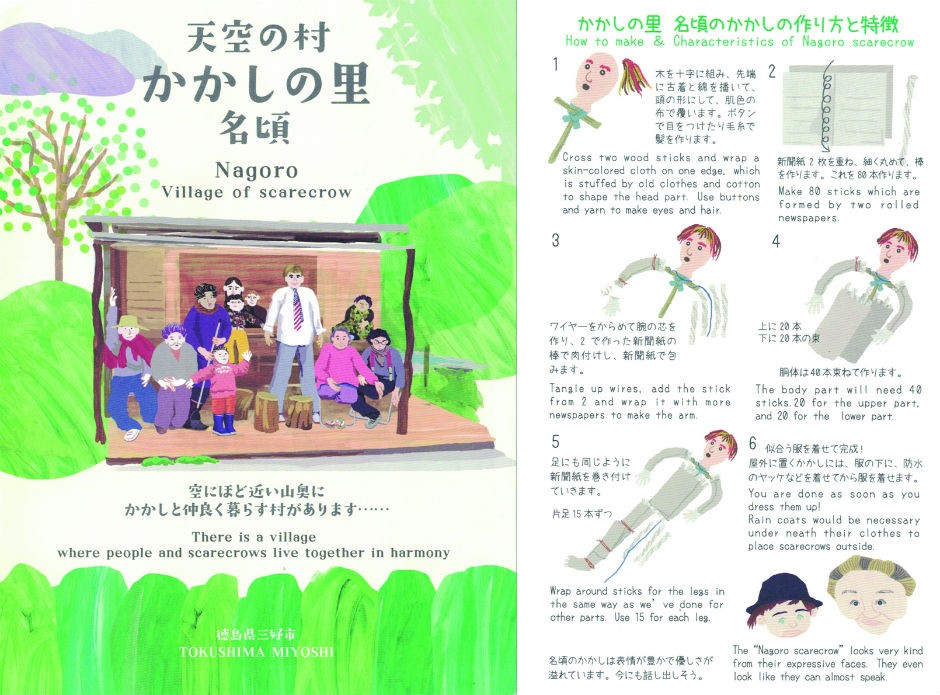 Cover and page five from the Nagoro Village of Scarecrow brochure.
Cover and page five from the Nagoro Village of Scarecrow brochure.
These dolls are a testament to those who were here before. Frozen, like residents of Pompeii, they watch over this quiet place. Waiting. They could be waiting for the local dam to require their labour. They could be waiting for the last residents of Nagoro to vacate their village. People brought them into the world simply to exist.
Their lackadaisical postures enhance the appearance of having nowhere to go. Effigies to the past, these scarecrows bring life to Nagoro in addition to bringing tourists like myself here.
Is there a place for dolls in Japan’s future? Japanese engineers have been working for decades to develop robots that can help perform care and services for an aging population. Designing for the optimal functionality and realism of robots has put Japanese researchers such as Hiroshi Ishiguro at the cutting-edge in the field of robotics.
Nagoro’s scarecrows were not the only humanoids I met on this trip. I saw large Buddhas, a sculpture of a life-sized ninja climbing a restaurant, dolls of all kinds lining toy store shelves, a mannequin waving at traffic on the highway — to signal a construction zone — and I met a tele-operated android called Otonaroid.
These humanoids all serve different purposes, but they are all part of everyday life. Whether animatronic, silicone or vintage, dolls are abundant in contemporary life. Expanding our understanding of what dolls can do and for whom is the first step in imagining the dolls of tomorrow. If their uncanniness is rooted in confusion over their purpose, I wonder whether their creepiness will endure as their numbers multiply.
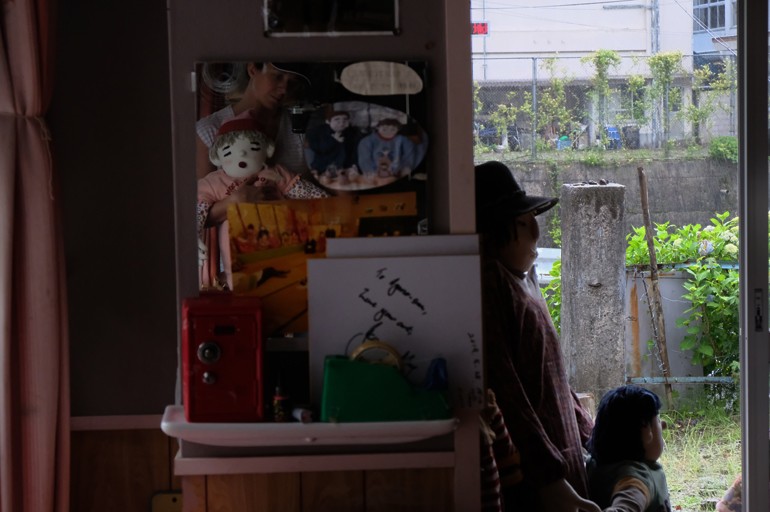
About the author



